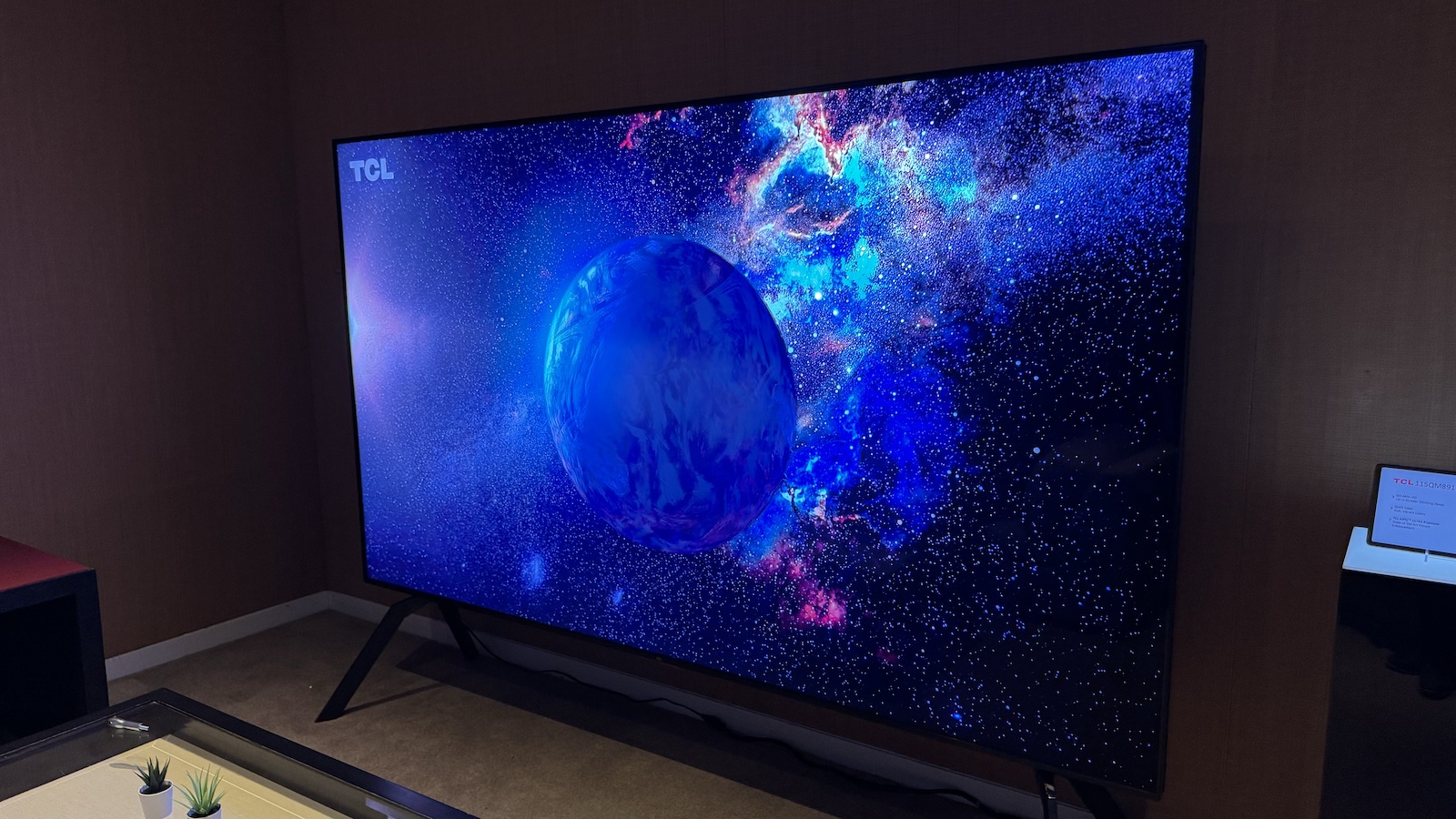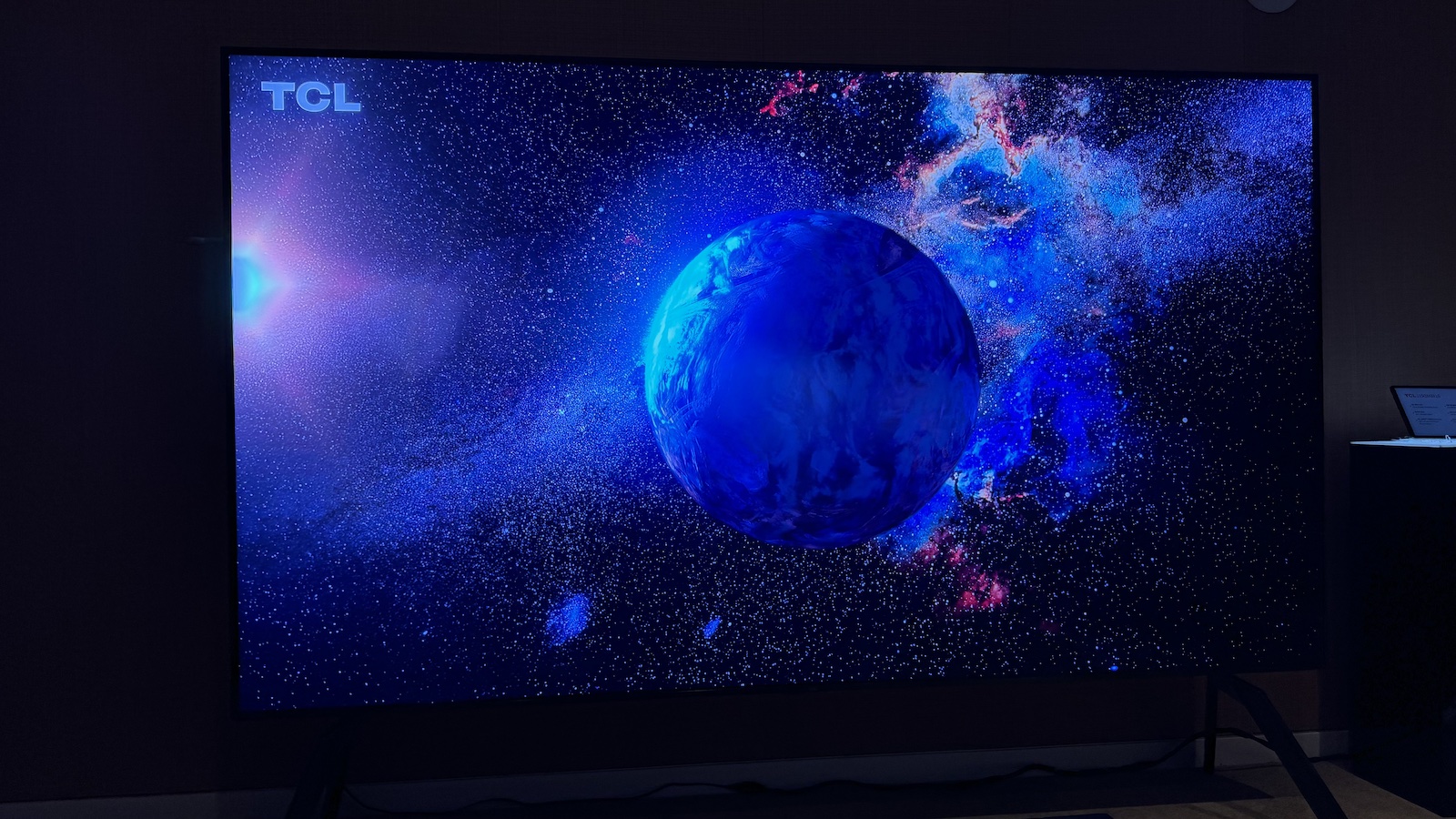I've seen the 115-inch TCL Mini LED TV in action and now I want it
But I definitely can't afford it...

I realise that some people feel the TV industry's recent obsession with super-sized TVs is misguided (What Hi-Fi?'s own Alastair Stephenson is one such person), but I'm not one of them. That's probably because I've got plans to one day turn my garage into a home cinema and a super-sized TV is more appealing to me than a projector.
It's not that I don't love projectors, because I do, but unless you spend huge amounts of money you're not going to get one that can do seriously deep blacks or make the most of bright HDR movies. There's the issue of movies in different aspect ratios looking odd against a projector screen, too, which can be overcome but not without quite a lot of extra expense and/or faff. I would also like to game in this hypothetical home cinema, and the vast majority of projectors have but a fraction of the gaming functionality of even a fairly entry-level TV.
That's why I've been watching this rise of massive TVs with keen interest, and when TCL announced the most massive Mini LED TV yet at CES 2024, I just had to go and check it out for myself. Let's just say I wasn't disappointed – at least not until I was told the price.
Fantastically bright and brilliantly black

It probably goes without saying that the 115-inch QM891G is absolutely huge. TCL had it set up in an extremely swanky suite in a Las Vegas hotel, and demonstrated how little metal handles can be screwed into the sides so that it can be lifted to a wall bracket or onto its feet. In the suite, TCL had placed the TV on a prototype easel-like stand that raised it a couple of feet off the floor – apparently, it won't come with this.
The chassis is angular and quite thick by modern TV standards, but it has a flat back that will allow for fairly flush wall mounting. The bezels are quite thick, too, but they're perfectly black. If I was to have this TV it would be mounted on a black wall so that in a pitch-black room you would see nothing but screen.
For the demo, I was sitting only around five feet from the screen. Far closer than you ever would for normal viewing but great for getting the full cinematic spectacle. Unfortunately (but predictably), I was only shown a loop of short demo clips rather than any real movie content, but I still developed some good first impressions.
Firstly, the TV goes incredibly bright. TCL says it is capable of going brighter than 5000 nits and I can well believe it. Highlights such as the sun setting over rolling hills were thrillingly punchy and dazzling – but in a good way. It's easy to imagine this level of brightness being wince-inducing, but I didn't find this to be the case.
The latest hi-fi, home cinema and tech news, reviews, buying advice and deals, direct to your inbox.
Just as importantly, blacks looked nice and deep. Admittedly, the demo room was quite brightly lit, which will have helped with the black performance, but I certainly didn't get the impression that there would be any issue with black depth if the lights were turned off.
Blooming was kept very well in check, too. The demo footage included some very stark tests of contrast – a sparkling, gem-encrusted ring against a pure black background, for example – and there was barely any glow around the bright highlights, particularly when viewing the TV head-on. The backlight has 20,000 separate dimming zones for this very reason.
Adding to the overall sizzle of the set were some super-vibrant colours. The set uses Quantum Dots and can apparently reproduce 98 per cent of the DCI-P3 spectrum; and the vibrancy and punch didn't look overly forced or unnatural during the demonstrations, though the content itself wasn't altogether 'natural'.
What did look a bit forced was the sharpness. The TV had clearly been put into one of its most aggressive processing modes for the demo, and the over-sharpening resulted in a bit of fizz to parts of the image. I expect this would be fixed by a switch to a preset with less-active processing, but there is a worry that this would also make it look a bit soft. Hopefully, TCL has achieved a good balance with at least one of the presets, but I would need much more time with the TV to find out.
Among the demo clips was one that was clearly in a lower resolution than the others, and this looked a bit rough and fuzzy. That's probably to be expected of a TV this large, though, particularly when viewing from such a short distance away.
Even with those slight reservations, I was really impressed by the 115QM89. We would need to spend a lot more time independently testing it before delivering a final verdict, but it broadly makes more sense to me than a projector, particularly when you add in next-gen gaming features such as 4K/120Hz and VRR. TCL also told me that the set will have "at least" two HDMI 2.1 sockets, explaining that the final specification is still being determined.
The kicker, though, is the price. I'm told that when it does launch, the 115-inch TCL QM891G will cost "under $20,000". I'm taking that to mean almost $20,000. I'm not saying that's not good value for a TV this huge – after all, your only option is really a six-figure Samsung Micro LED model – but it is a very large amount of money that puts it against some truly exceptional projectors and puts it well out of the reach of someone like me. That said, this is a first-generation device and there is every chance that more affordable models will follow in time. It's going to be a while before I'm ready to convert my garage anyway...
MORE:
These are the best TVs you can buy right now
And these are the best projectors
Check out all of the news from CES 2024
Tom Parsons has been writing about TV, AV and hi-fi products (not to mention plenty of other 'gadgets' and even cars) for over 15 years. He began his career as What Hi-Fi?'s Staff Writer and is now the TV and AV Editor. In between, he worked as Reviews Editor and then Deputy Editor at Stuff, and over the years has had his work featured in publications such as T3, The Telegraph and Louder. He's also appeared on BBC News, BBC World Service, BBC Radio 4 and Sky Swipe. In his spare time Tom is a runner and gamer.

